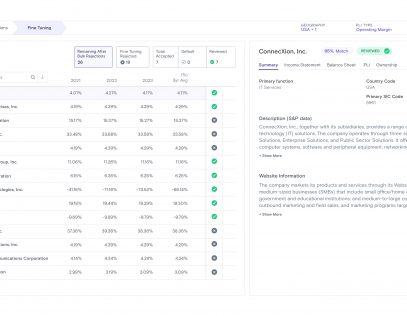Transfer pricing compliance is tricky in the best of times, but periods of economic uncertainty bring about unique challenges: Should limited-risk activities still earn routine returns for companies in loss positions? Will comparable companies still be reliable if inflation impacts them differently? How relevant is a three-year range under extraordinary circumstances?
In unpredictable economies, many transfer pricing executives have taken a fingers-crossed approach to compliance. To help minimize the guesswork, in a recent Exactera’ podcast, Chief Economist Mimi Song, and transfer pricing expert Barbara Mantegani, offered advice on documenting intercompany transactions in today’s world of inflation, climbing interest rates, and economic slowdown.
Below, you’ll find a few takeaways from their conversation. For a deeper dive, listen to the podcast.
How companies respond to inflation will impact transfer pricing. Many companies are raising prices, which presents obvious problems for consumers, but from a transfer pricing perspective it builds a foundation for unreliable benchmarking. In some countries, inflation may be worse than others. “It could have an impact on pricing. It could have an impact on results,” says Mantegani who owns Mantegani Tax in McLean, Virginia. Severe inflation in one country and lesser inflation in another can throw a wrench into proving cross-border arm’s length pricing. Be prepared to explain how inflation has impacted local entities and the group overall. Says Mantegani, “To the extent that all of your projections were set on fire by the pandemic and the subsequent inflation then you just have to rewrite, reexplain, and recalculate in terms of being able to comply with transfer pricing rules.”
Tax authorities may question intercompany loans due to rising interest rates. To slow inflation, central banks like the Federal Reserve and the Bank of England have been increasing benchmark interest rates. How that impacts transfer pricing will vary between businesses, but intercompany loans may require modification. “Typically, intercompany loans are in some way or another, tied to market rates,” says Mantegani. “If the market rates are going up and there aren’t adjustments to intercompany loans, it could create the question whether those are arm’s length dealings. If you were dealing with an unrelated party, would you not increase the rate that you would charge?” explains Mantegani, who advises reviewing documentation and explaining the current economic reality.
Intangible assets will attract scrutiny. Intangible assets are always of interest in the transfer pricing space. These one-of-a-kind assets are hard to benchmark and thus, hard to value. Tax authorities pay special attention to intangible assets in all economic environments, as we’ve seen from Coca-Cola and Medtronic, but in an uncertain economy they could present even more opportunities for tax authorities. “Intangible assets could be the differentiator between winning and losing in uncertain economic climates,” says Song.
Economic uncertainty can bring about industry-specific issues or geographic-specific issues. “An asset that at one time generated revenue may bring in less if nobody is buying what you’re selling,” says Mantegani. “All sorts of things can have an impact on the value of your intangible asset and what you charge somebody to exploit it.” These events are fine, but you must be able to explain your situation to a tax authority. Why is this year different from others? “As long as what you are telling the tax authority makes sense from a business perspective, then ultimately, it’s going to make sense from a tax perspective. It’s when you let tax lead the bus, that’s when you’re in trouble,” says Mantegani.
Documenting contemporaneously is critical. Years ago, tax executives would prepare documentation and then the next year maybe update a few numbers. Often, they’d put off reviewing the full documentation package and revisiting their analyses for another three to five years. While that approach may have worked way back when, it certainly won’t fly now. In our post-BEPS world documentation will likely be reviewed, and if it doesn’t reflect the reality of business today, tax authorities are sure to have questions.
Uncertain economic times add an extra layer of complexity as businesses have likely made structural changes. Maybe a few entities closed, and others have had to take on additional functions to support the group. Such evolution has to be reflected in transfer pricing documentation and the only way to accurately track how a business has morphed is to do it contemporaneously. Documenting in real time will strengthen your transfer pricing narrative, enable you to include important details, and spare you and other executives from duplicate work later on. “I always think it’s important that the narrative reflects the evolution of the business, so you don’t have to do that big bang every three to five years where you’re interviewing every single person in the company again and they say, ‘didn’t we just do this?’” says Song.
Limited risk is not the same as no risk. Whether you’re in technology, automotive, retail, pharmaceuticals, or any other industry, there is always risk in business. A warehouse can burn down. Competition can creep up on you. A pandemic can occur. From a transfer pricing perspective, though, the question is relatively simple: In such a situation, would you still report a routine return of 3% to 5% in a particular country? Many transfer pricing executives are surprised to learn that generally speaking, the answer is, no. “If the bottom line for the company is red then it’s extremely challenging to justify to the parent country that it has to be redder in this country, so it can be black in these other countries. That’s not an easy argument to make,” says Mantegani.
The three-year range might not mean the last three years. Unusual times call for out-of-the-box thinking. If the last three years aren’t representative of how your business is performing today, then you may need to turn back the clock even further to when the three-year average is similar to what you’re testing this year. Of course, that kind of maneuver will require explanation in your transfer pricing narrative.
“It comes down to the explanation, the story. And by story, I don’t mean once upon a time there was a prince and a princess. I mean the actual story of the company. And the functions and risks that apply to this particular company and the business structure and why the business structure is the way it is,” says Mantegani.
To hear an in-depth discussion of how an economic slowdown can impact your transfer pricing compliance, listen to “Transfer Pricing Through Economic Uncertainty.”








